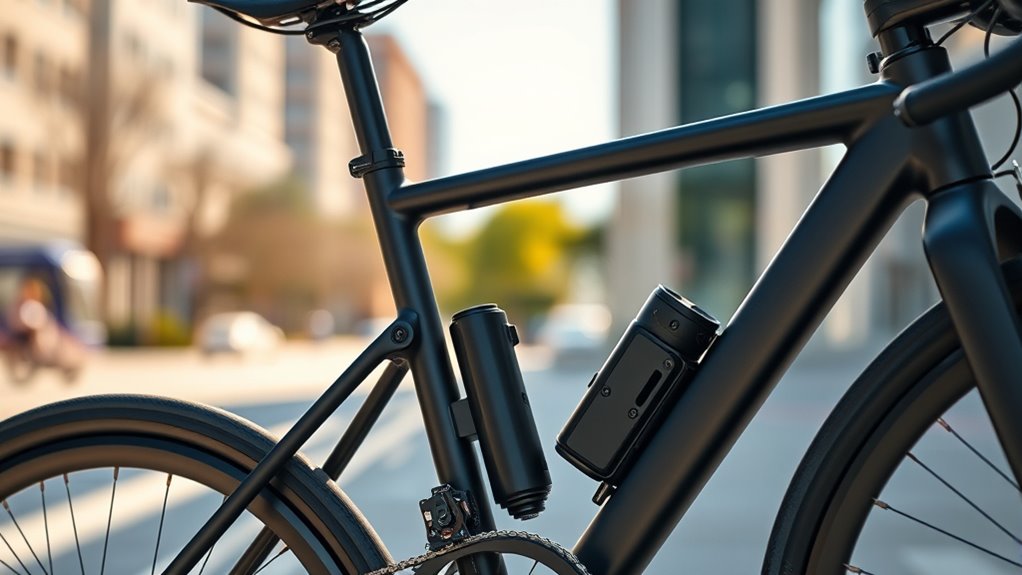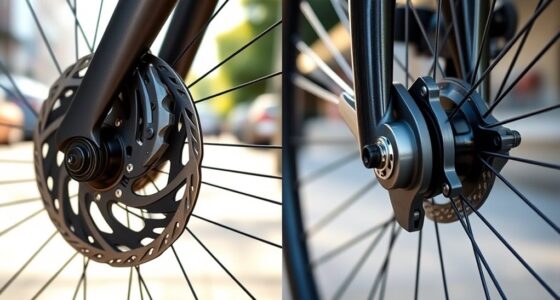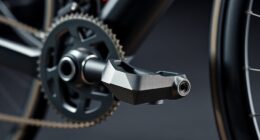Wireless drivetrains use electronic signals and rechargeable batteries to control gear shifts without cables, offering smoother, more precise changes and easier maintenance. They’ve evolved from mechanical to electronic and now wireless systems, improving aesthetics and performance. While they reduce clutter and simplify setup, challenges like signal interference and battery life still exist. If you’re curious about whether cables will truly disappear soon, you’ll find more insights ahead.
Key Takeaways
- Wireless drivetrains eliminate cables for cleaner, lighter bikes and easier maintenance, enhancing overall aesthetics and aerodynamics.
- They offer precise, automatic shifting with advanced signal encryption, reducing the need for manual adjustments.
- Wireless systems are more susceptible to interference and have higher power consumption, impacting battery life and reliability.
- Cabled systems provide consistent performance unaffected by wireless signal issues but require more upkeep and cable management.
- Industry trends show ongoing innovation, but both wireless and cable systems have unique advantages, so cables are not entirely obsolete.
How Wireless Drivetrains Work

Wireless drivetrains eliminate the need for traditional mechanical connections by transmitting power and control signals electronically. They rely on a rechargeable battery, which manages power delivery to the motor and sensors. Proper battery management guarantees consistent performance and prevents sudden drops in power. The system communicates via Bluetooth or proprietary wireless signals, allowing seamless shifting and motor control. Signal interference from other electronic devices can disrupt communication, so manufacturers incorporate encryption and error correction. Additionally, wireless technology reliability is crucial for ensuring consistent operation in various environments. The components include a sensor, a controller, and a motor, all linked wirelessly. When you shift gears or adjust assistance levels, signals are sent instantly, enabling smooth operation. This setup reduces clutter and maintenance, making your ride cleaner and more reliable, provided the system is well-protected against interference.
The Evolution of Bicycle Shifting Technologies
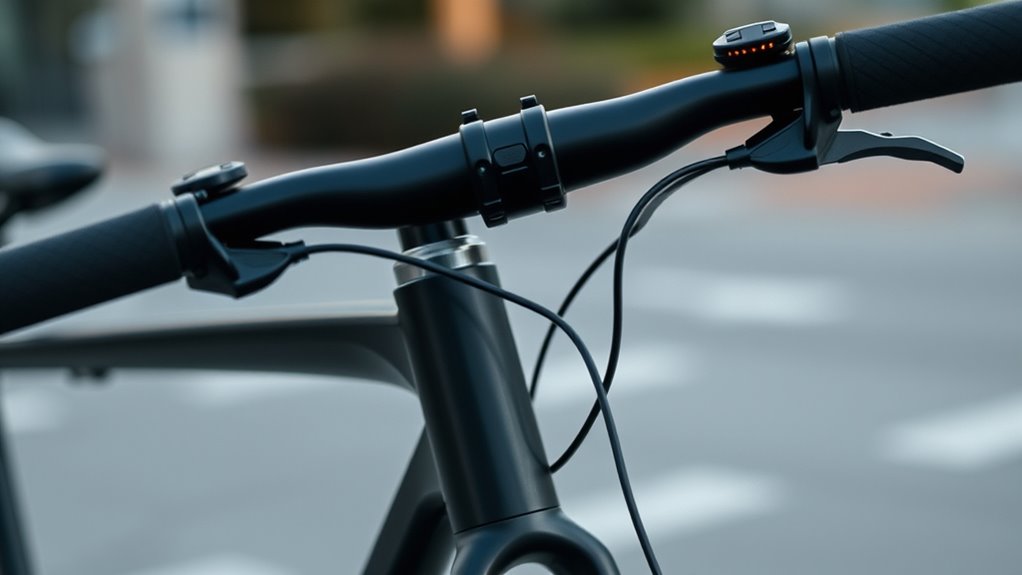
You’ve probably noticed how bicycle shifting has changed over time. Mechanical systems gave way to electronic, offering smoother and more precise gear changes. Now, wireless technologies are transforming how we shift gears altogether. This advancement mirrors innovations seen in automotive tuning, where performance upgrades such as ECU remapping and exhaust enhancements are increasingly integrated with modern vehicle systems. Additionally, the integration of wireless drivetrain control allows for even greater customization and ease of use for drivers and cyclists alike. As these wireless systems continue to evolve, they promise to make gear shifting more intuitive and maintenance-free, similar to how online privacy tools have enhanced digital security. The development of wireless communication protocols ensures reliable and synchronized operation of the drivetrain components without physical connections. Furthermore, these systems utilize battery management technologies to optimize energy efficiency and prolong component lifespan.
Mechanical to Electronic Shifting
The changeover from mechanical to electronic shifting has transformed how you control your bike, offering greater precision and reliability. Electronic systems automatically adjust gear changes, reducing the chance of mis-shifts. You need to verify gear compatibility between components to achieve smooth shifting performance, especially when upgrading or mixing brands. Battery life is a vital consideration, as it determines how long your shifting system remains operational before needing a recharge. Modern electronic shifters typically feature long-lasting batteries, but heavy use or extreme conditions can drain them faster. This shift has made maintenance easier and shifting more consistent, giving you confidence on every ride. Additionally, choosing the right free keto diet app can help you monitor your diet, ensuring optimal performance and health while embracing electronic shifting. Overall, electronic shifting enhances your riding experience by providing seamless, accurate gear changes without the fuss of mechanical cables.
Rise of Wireless Systems
As bicycle shifting technology advances, wireless systems have emerged as a game-changer, removing the need for cables and simplifying installation. Modern battery technology powers these systems efficiently, offering longer life and lighter setups. However, signal interference remains a concern, especially in crowded areas with many electronic devices. Manufacturers address this by using secure, encrypted signals to prevent accidental shifts.
| Advantage | Challenge |
|---|---|
| Easy installation | Signal interference risks |
| Cleaner aesthetics | Battery management needed |
| Reduced weight | Limited battery life |
| Less maintenance | Compatibility issues |
| Seamless shifting | Higher initial cost |
Wireless systems revolutionize shifting, but you still need to contemplate battery and interference factors for optimal performance.
Advantages of Going Wireless
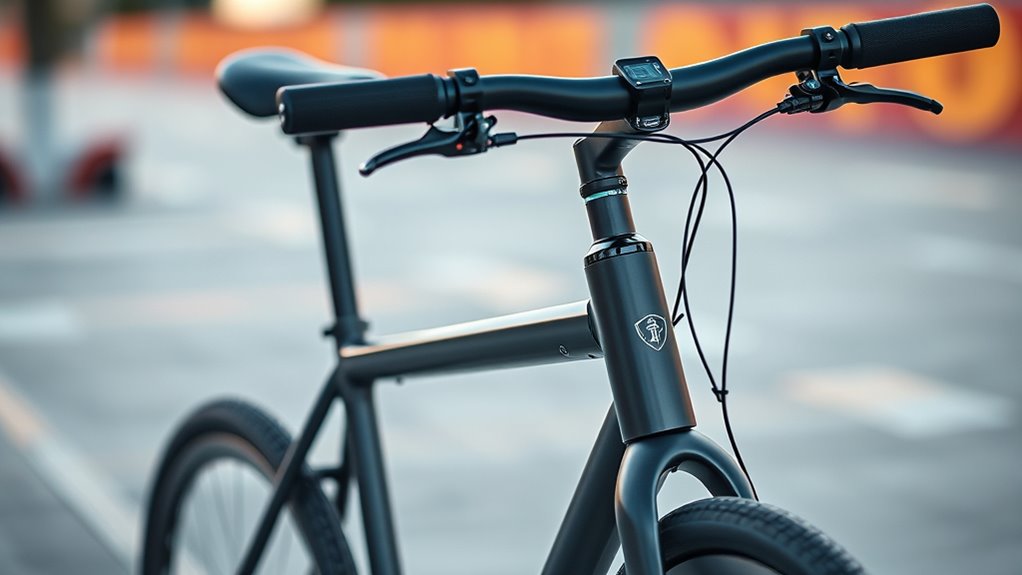
Switching to wireless drivetrains reduces bike clutter and improves its sleek look. You’ll find it easier to maintain and set up without tangled cables. Plus, wireless systems often last longer and perform more reliably in tough conditions. Additionally, the absence of cables allows for a cleaner design aesthetic, enhancing the overall appearance of your bike. Proper installation and understanding of retirement planning can also ensure that your investment in wireless components aligns with your long-term cycling goals. Embracing component compatibility is essential for seamless integration and optimal performance, especially since advancements in wireless technology aim to improve signal stability and reduce latency during rides.
Reduced Clutter and Aesthetics
Going wireless considerably reduces the clutter that traditional drivetrains create on your bike. Without cables and housing, your bike looks cleaner and more streamlined. This minimalist design enhances the aesthetic appeal, making your bike not only easier on the eyes but also more enjoyable to ride. Here are three benefits:
- Cleaner appearance – cables and housing are eliminated, resulting in a sleek look.
- Enhanced aerodynamics – fewer components mean less drag, improving performance.
- Simplified setup – no tangled cables, making installation neater and more straightforward. Automation in business techniques further demonstrate how removing excess components can improve overall performance and style, promoting space and organization on your bike. Additionally, wireless technology contributes to a cleaner setup by reducing maintenance and potential points of failure.
Easier Maintenance and Setup
Without cables and housing to manage, maintaining and setting up wireless drivetrains becomes considerably simpler. You’ll spend less time troubleshooting cable issues and more time riding. Diagnostic tools integrated into wireless systems allow quick identification of problems, reducing downtime and simplifying repairs. Setup is straightforward, often requiring just a few steps through a dedicated app or device, which minimizes user training. This streamlined process helps you get your bike ready faster, whether during initial installation or routine maintenance. Wireless drivetrains eliminate the need to thread cables through frames or adjust housing, making adjustments and upgrades easier. Additionally, the ease of customization makes it simple to adapt your setup to your riding style or preferences. As a bonus, the reduction of clutter contributes to a cleaner bike appearance and improved aerodynamics. Overall, you’ll find that the absence of cables makes maintenance less of a chore and setup more intuitive, saving you time and effort on every ride.
Enhanced Durability and Reliability
Wireless drivetrains often deliver greater durability and reliability because they eliminate vulnerable cables and housing that can wear out or get damaged over time. Without cables, your bike resists issues like corrosion, which often affects traditional wiring, and benefits from improved shock absorption, reducing stress on components. To maximize durability, consider these advantages:
- Corrosion Resistance: Wireless systems are sealed, preventing moisture and dirt from causing rust or corrosion.
- Enhanced Shock Absorption: Fewer moving parts mean less risk of damage from impacts or vibrations.
- Reduced Wear and Tear: Without cables or housing, there’s less chance of fraying, kinks, or breakage, ensuring consistent performance over time.
- Wireless Connectivity can also inspire ideas for a stylish, modern approach to naming your bike components or accessories, reflecting a refined aesthetic. Additionally, the reliability of wireless systems makes them ideal for demanding riding conditions, ensuring consistent operation regardless of terrain.
Challenges and Limitations of Wireless Systems

Despite their many advantages, wireless drivetrains face significant challenges that can hinder their performance and reliability. Signal interference from other electronic devices can disrupt communication between components, leading to misshifts or loss of control. This interference is especially problematic in urban environments with dense wireless signals. Additionally, wireless systems tend to consume more power than traditional cables, which can reduce battery life and increase maintenance needs. Managing power consumption without sacrificing performance remains a delicate balance. You might also encounter latency issues, where delays in signal transmission affect shifting responsiveness. These limitations can impact your riding experience, making wireless drivetrains less dependable in certain conditions. Overcoming these challenges requires ongoing advancements in signal stability and energy efficiency, such as cutting-edge trends that improve reliability and performance.
Comparing Wireless and Traditional Cable Systems

When comparing wireless and traditional cable systems, the differences in reliability, performance, and maintenance become quite apparent. Wireless systems offer convenience but face challenges like signal interference that can disrupt power delivery. Additionally, battery efficiency plays a vital role; wireless drivetrains depend on batteries, which require regular charging and can lose effectiveness over time. Here are key points to contemplate:
Wireless systems offer convenience but face interference and battery maintenance challenges.
- Cable systems provide consistent power without interference, ensuring steady performance.
- Wireless setups simplify installation but may suffer from signal interference, affecting reliability.
- Battery efficiency impacts wireless systems’ longevity, requiring maintenance to keep performance ideal.
Major Brands and Models in Wireless Drivetrains
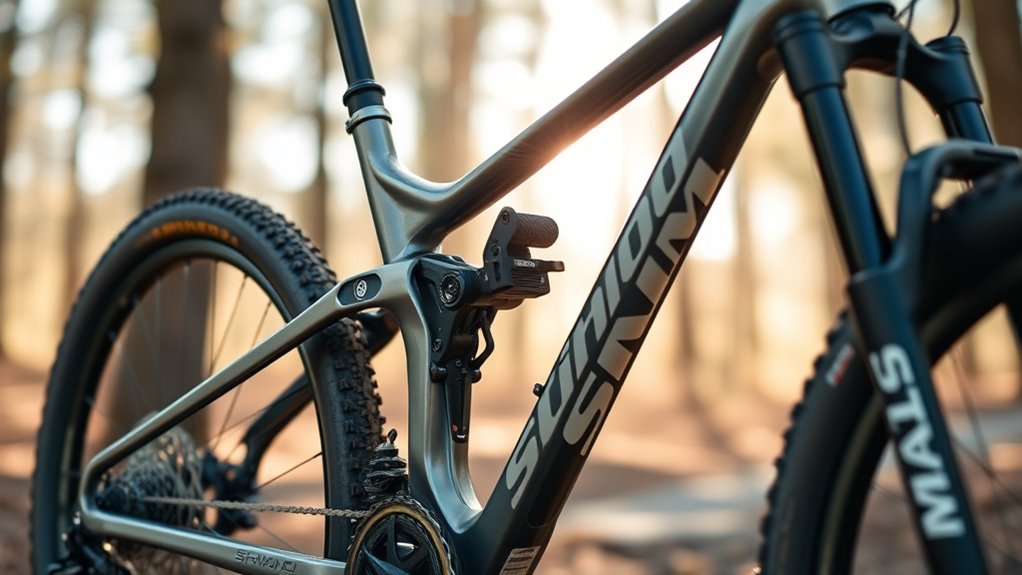
Have you wondered which brands lead the way in wireless drivetrains? Major players like Shimano, SRAM, and Campagnolo offer models with impressive features. Shimano’s Di2 systems are known for their strong brand compatibility across many bikes and reliable battery life, making them popular among enthusiasts. SRAM’s AXS series boasts seamless connectivity and customizable options, with battery life designed for long rides. Campagnolo’s e-Shift wireless systems focus on precision and durability, catering to high-end bikes. While each brand has its unique strengths, all prioritize efficient battery management and compatibility with various bike setups. These models show that wireless drivetrains are advancing rapidly, offering riders more flexibility, fewer cables, and improved performance.
Installation and Maintenance Considerations

Installing and maintaining wireless drivetrains requires careful attention to setup procedures and ongoing care to guarantee ideal performance. First, verify proper alignment during installation to prevent cable corrosion and signal issues. Second, regularly check the gear adjustment to keep shifting smooth and responsive. Third, clean components periodically, especially around the hub and sensors, to avoid dirt buildup that can interfere with wireless signals. Unlike traditional systems, wireless drivetrains eliminate cable corrosion concerns, but you still need to confirm that connections stay secure. Proper gear adjustment is vital for consistent shifting, so don’t neglect it. Keep an eye on battery levels and update firmware when needed to maintain peak performance. These steps will help you enjoy reliable, hassle-free operation of your wireless drivetrain.
Real-World Performance and Reliability
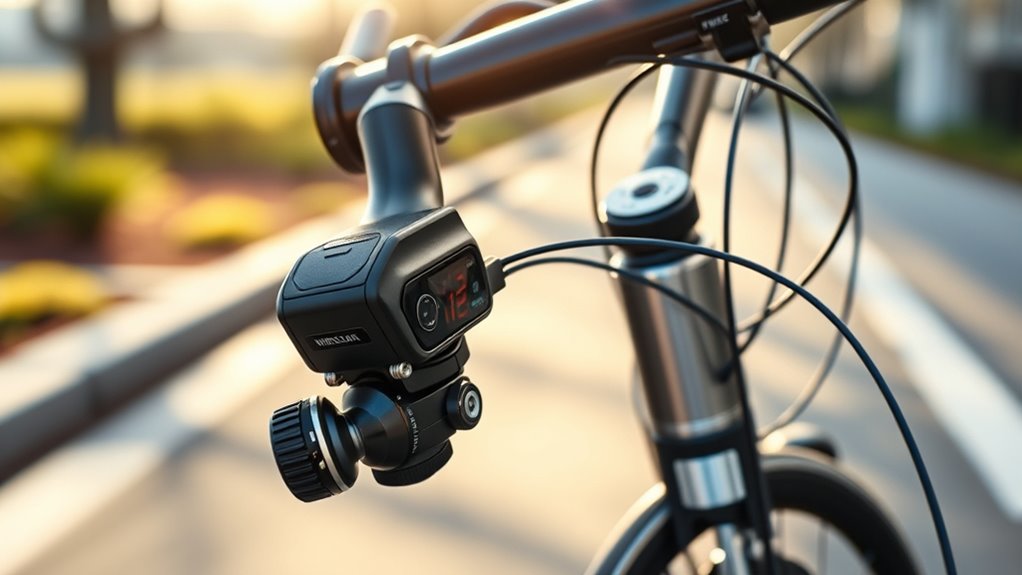
Wireless drivetrains deliver impressive performance in real-world conditions, often matching or exceeding traditional systems. You’ll notice smooth shifting and quick response, even on challenging terrains. Battery life has improved markedly, providing enough charge for long rides without frequent recharging. However, interference issues can occasionally disrupt signals, especially in crowded urban areas with many electronic devices. While most systems are designed to minimize these disruptions, you might experience brief hiccups if you’re near strong sources of wireless signals. Overall, you can rely on wireless drivetrains for consistent performance, but it’s wise to keep an eye on battery levels and be aware of potential interference in busy environments. These advancements make wireless systems a practical, high-performance choice for everyday riding.
The Future of Wireless Bicycle Technology
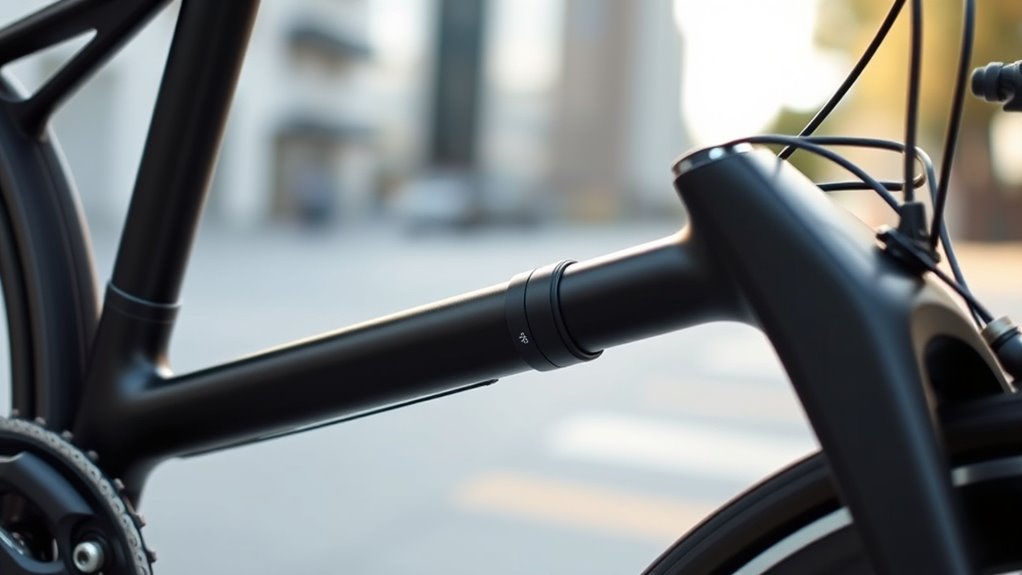
As technology continues to advance, the future of wireless bicycle systems looks brighter, with innovations promising even greater performance, convenience, and integration. You can expect improvements like:
- Enhanced battery efficiency, allowing longer rides without frequent charging.
- Better signal interference management, ensuring smooth shifts and reliable communication even in busy urban areas.
- Smarter integration with digital devices, providing real-time data and customization options.
These advancements will make wireless drivetrains more dependable and user-friendly. Developers are actively addressing challenges like optimizing power consumption and minimizing signal disruptions. As a result, wireless systems will become more seamless, reducing the need for maintenance and increasing your riding pleasure. The future holds a landscape where wireless bicycle technology is not just a luxury but a standard feature for riders worldwide.
Are Cables Truly Becoming Obsolete?
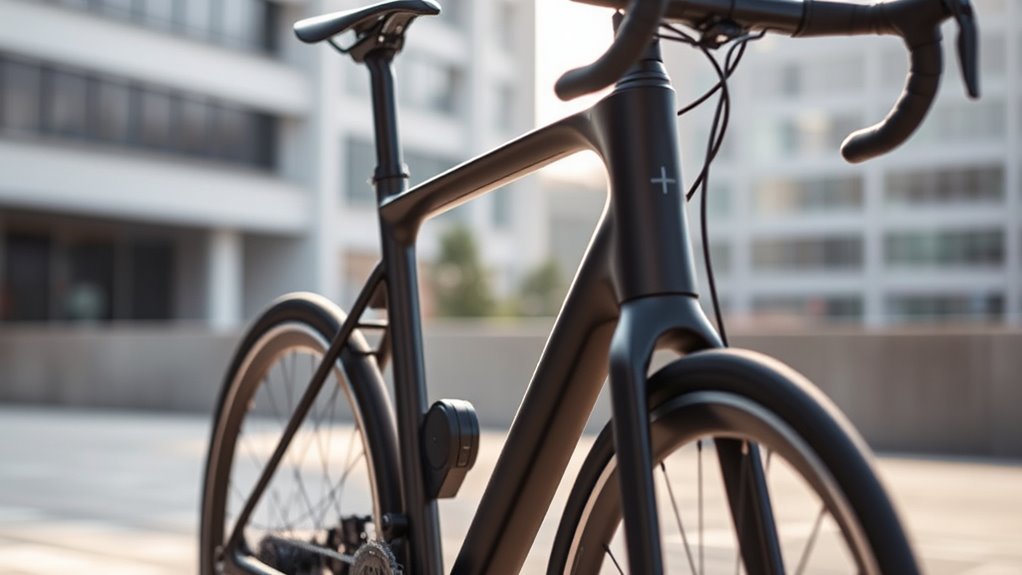
Are cables truly becoming obsolete in the world of bicycle technology? While wireless systems gain popularity, cables still offer unmatched wired reliability and durability. They resist interference and harsh conditions better, ensuring consistent performance. Cables are less prone to connection issues and require less frequent maintenance, making them dependable for long rides. However, some worry about cable wear and tear over time. Here’s a quick comparison:
| Feature | Cables | Wireless |
|---|---|---|
| Cable durability | High, resistant to elements | Limited by battery life |
| Wired reliability | Very dependable, minimal lag | Can face interference |
| Maintenance | Occasional replacements needed | Less maintenance, more tech |
Despite advances, cables still hold strong in reliability and durability.
Frequently Asked Questions
What Is the Typical Lifespan of Wireless Drivetrain Components?
Wireless drivetrain components typically last around 2 to 3 years, depending on usage and maintenance. Battery longevity plays a key role, as batteries gradually lose capacity over time, affecting performance. Component durability also matters; high-quality parts tend to withstand the elements and frequent riding better. You should regularly check for software updates and keep batteries charged properly to maximize lifespan. Proper care guarantees your wireless drivetrain remains reliable and efficient longer.
How Secure Are Wireless Shifting Systems Against Hacking or Interference?
Wireless wonders worry you with hacking vulnerabilities, but you can breathe easier. Modern wireless shifting systems employ advanced encryption standards, making malicious hacking much more difficult. While no system is completely invulnerable, the security measures considerably limit interference and unauthorized access. So, you can trust these systems to transmit signals safely, staying synchronized and secure, without sacrificing the sleek, cable-free convenience you crave.
Can Wireless Drivetrains Be Used in Extreme Weather Conditions?
You can absolutely use wireless drivetrains in extreme weather conditions, but keep in mind rain resistance varies by system. Look for models specifically designed to handle wet environments, ensuring they resist water and moisture. Also, consider signal interference, which can be more common in harsh weather. Many modern wireless drivetrains feature advanced shielding and robust signals, making them reliable even in heavy rain or challenging conditions.
Are Wireless Systems Compatible With All Bike Types and Brands?
You might wonder if wireless systems fit all bike types and brands. Compatibility issues can arise, especially since not every brand supports wireless drivetrains. Some brands design their bikes specifically for wired systems, so you could face compatibility problems. Before upgrading, check your bike’s make and model against the wireless drivetrain’s specifications. This way, you avoid surprises and guarantee seamless integration with your preferred brand and bike type.
What Is the Cost Difference Between Wireless and Traditional Cable Systems?
When comparing wireless and traditional cable systems, you’ll find a notable cost difference. Wireless setups generally cost more upfront due to advanced technology and installation. An affordability analysis shows that, while wireless systems save you maintenance and cable replacement costs, the initial investment can be significant. If budget is a concern, traditional cable systems remain more affordable, but wireless offers convenience and cleaner aesthetics that might justify the higher price for some riders.
Conclusion
As wireless drivetrains become more popular, it’s clear cables might soon be a thing of the past. For instance, over 60% of new high-end bikes now feature wireless systems, highlighting their growing adoption. While challenges remain, the convenience and sleek design make wireless setups appealing. If current trends continue, you’ll likely see fewer bikes with traditional cables in the near future, transforming your riding experience into a cleaner, more efficient ride.
